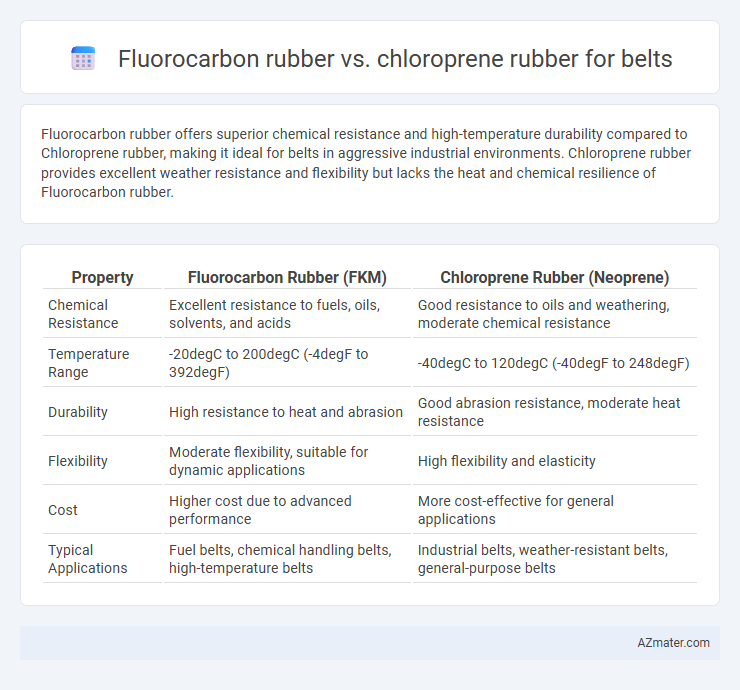Fluorocarbon rubber offers superior chemical resistance and high-temperature durability compared to Chloroprene rubber, making it ideal for belts in aggressive industrial environments. Chloroprene rubber provides excellent weather resistance and flexibility but lacks the heat and chemical resilience of Fluorocarbon rubber.
Table of Comparison
| Property | Fluorocarbon Rubber (FKM) | Chloroprene Rubber (Neoprene) |
|---|---|---|
| Chemical Resistance | Excellent resistance to fuels, oils, solvents, and acids | Good resistance to oils and weathering, moderate chemical resistance |
| Temperature Range | -20degC to 200degC (-4degF to 392degF) | -40degC to 120degC (-40degF to 248degF) |
| Durability | High resistance to heat and abrasion | Good abrasion resistance, moderate heat resistance |
| Flexibility | Moderate flexibility, suitable for dynamic applications | High flexibility and elasticity |
| Cost | Higher cost due to advanced performance | More cost-effective for general applications |
| Typical Applications | Fuel belts, chemical handling belts, high-temperature belts | Industrial belts, weather-resistant belts, general-purpose belts |
Introduction to Fluorocarbon and Chloroprene Rubber Belts
Fluorocarbon rubber belts offer superior chemical resistance, high-temperature tolerance up to 200degC, and excellent durability in harsh industrial environments compared to chloroprene rubber belts. Chloroprene rubber belts provide good abrasion resistance, flexibility, and moderate chemical stability, making them suitable for general-purpose applications with temperatures up to 120degC. Selection between fluorocarbon and chloroprene rubber belts depends on specific operational requirements, such as exposure to aggressive chemicals, temperature ranges, and mechanical stress.
Chemical Composition and Structure Comparison
Fluorocarbon rubber (FKM) features a polymer backbone primarily composed of vinylidene fluoride and hexafluoropropylene, providing exceptional resistance to heat, oils, and chemicals due to its strong carbon-fluorine bonds. Chloroprene rubber (CR), made from chloroprene monomers, contains chlorine atoms in its polymer chain that afford good chemical stability and moderate resistance to ozone, oils, and weathering. The fluorinated structure of FKM offers superior chemical inertness and thermal stability compared to the less chemically robust but more versatile chloroprene backbone, influencing their performance in demanding belt applications.
Temperature Resistance: Fluorocarbon vs. Chloroprene
Fluorocarbon rubber exhibits superior temperature resistance, maintaining stability in continuous use up to 204degC (400degF), whereas chloroprene rubber typically withstands temperatures only up to 120degC (248degF). This enhanced thermal performance makes fluorocarbon ideal for belts exposed to high heat or harsh chemical environments. Chloroprene, while more cost-effective, is less suitable for high-temperature applications due to its lower thermal tolerance.
Chemical Resistance Performance
Fluorocarbon rubber exhibits superior chemical resistance compared to chloroprene rubber, particularly against oils, fuels, and aggressive solvents, making it ideal for belts exposed to harsh chemical environments. Chloroprene rubber offers moderate chemical resistance but is more susceptible to degradation by hydrocarbons and certain acids. For applications requiring long-lasting durability and resistance to a broad spectrum of chemicals, fluorocarbon rubber belts provide enhanced performance and reliability.
Mechanical Properties and Durability
Fluorocarbon rubber exhibits superior mechanical properties compared to chloroprene rubber, including higher tensile strength and excellent resistance to abrasion, making it ideal for belts subjected to heavy mechanical stress. Its exceptional durability against heat, oil, and chemical exposure surpasses that of chloroprene, ensuring longer service life in harsh industrial environments. Chloroprene rubber offers moderate flexibility and good overall weather resistance but falls short of fluorocarbon's enhanced mechanical resilience and chemical stability in demanding applications.
Flexibility and Elasticity in Belt Applications
Fluorocarbon rubber offers superior chemical resistance but exhibits lower flexibility and elasticity compared to chloroprene rubber, making it less ideal for dynamic belt applications requiring frequent bending and stretching. Chloroprene rubber provides excellent flexibility and high elasticity, ensuring better performance in belts subjected to continuous flexing and elongation. In belt applications prioritizing dynamic movement and durability, chloroprene rubber outperforms fluorocarbon rubber by maintaining integrity under repetitive stress.
Cost Implications: Fluorocarbon vs. Chloroprene
Fluorocarbon rubber belts typically incur higher initial costs compared to chloroprene rubber due to advanced chemical composition and superior resistance to heat, chemicals, and oils. Chloroprene belts offer a more cost-effective solution for general-purpose applications with moderate exposure, balancing affordability and durability. Long-term maintenance savings with fluorocarbon materials can offset upfront expenses in demanding environments, enhancing overall value despite higher procurement costs.
Common Industrial Applications for Each Rubber
Fluorocarbon rubber excels in high-temperature and chemical-resistant belt applications such as automotive fuel systems, aerospace seals, and chemical processing equipment due to its superior heat, oil, and solvent resistance. Chloroprene rubber is commonly used in conveyor belts, agricultural machinery, and general-purpose industrial belts because of its excellent abrasion resistance, moderate chemical resistance, and flexibility in diverse environmental conditions. Industrial sectors requiring durability against harsh chemicals and extreme temperatures prefer fluorocarbon rubber belts, while chloroprene rubber belts are favored for their balance of mechanical properties and cost-effectiveness.
Lifespan and Maintenance Requirements
Fluorocarbon rubber belts exhibit superior chemical resistance and durability, resulting in a longer lifespan compared to chloroprene rubber belts, which tend to degrade faster under harsh conditions. Maintenance requirements for fluorocarbon rubber belts are lower due to their enhanced resistance to oils, heat, and ozone, reducing the frequency of replacements and repairs. Chloroprene rubber belts demand more regular inspections and maintenance to prevent premature wear and failure, especially in environments with exposure to chemicals and extreme temperatures.
Choosing the Right Rubber for Belt Solutions
Fluorocarbon rubber offers superior chemical resistance, high temperature tolerance up to 230degC, and excellent aging properties, making it ideal for harsh industrial belt applications involving oils, solvents, and extreme environments. Chloroprene rubber provides good abrasion resistance, moderate chemical resistance, and flexibility at low temperatures, suitable for general-purpose conveyor belts in less demanding conditions. Selecting the right rubber for belt solutions depends on the operating environment, required durability, and exposure to chemicals and temperatures.

Infographic: Fluorocarbon rubber vs Chloroprene rubber for Belt
 azmater.com
azmater.com